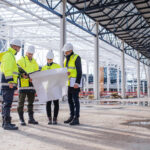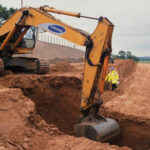Imagine a world where every building tells a story, every wall has a voice, and every brick holds a secret. This isn’t just poetic imagery; it’s the reality of the role that bricks have played in shaping our civilization. But what makes bricks so special?
Crafted from earth, molded by hands, and fired with precision, bricks are the essence of sustainable construction. Their remarkable journey from humble clay to robust structures is a dance of technology, art, and environmental stewardship.
In this article, we will unravel the world of bricks, delving into their history, manufacturing process and their technological advancements. So buckle up and read on!

Main Content
1. Advantages of Sustainable Bricks
Sustainable bricks offer several significant advantages compared to traditional bricks made from conventional materials. These advantages stem from their environmentally friendly production processes and their positive impact on reducing the overall carbon footprint. Here are some key benefits of sustainable bricks:
Reduced Carbon Footprint
Sustainable bricks are designed to minimize carbon emissions by employing energy-efficient production methods. Techniques like kiln-free firing and utilizing industrial waste significantly reduce the carbon footprint, making them an eco-friendlier choice.
Also Read: How many Bricks needed to build a house? 1000 sq ft, 1,500 sq. ft, 1,600, 1,800 sq.ft.
Enhanced Thermal Insulation
Incorporating innovative materials within sustainable bricks enhances thermal insulation properties, reducing the need for excessive heating or cooling systems. This not only conserves energy but also ensures a comfortable living environment.
Minimal Resource Depletion
Sustainable bricks often utilize recycled materials, curbing the demand for virgin resources. By reimagining waste as a valuable asset, these bricks contribute to the circular economy while reducing environmental strain.
2. Innovative Techniques in Brick Manufacturing
Innovative techniques in brick manufacturing highlight the ongoing efforts to create more potential to revolutionize the construction industry and contribute to a greener future. Here are some innovative techniques that must be explored:
Like Us on Facebook!

Recycled Bricks
Recycled bricks, crafted from post-consumer waste like glass and concrete, exemplify the essence of sustainability. They not only repurpose waste but also possess structural integrity, proving that eco-consciousness doesn’t compromise quality.
Subscribe Us on YouTube!
Also Read: Brick Masonry Calculator – Calculate No. of Bricks required in a wall
Biomaterial-based Bricks
By harnessing the power of natural binders and fibers, biomaterial-based bricks offer a biodegradable alternative. These bricks decompose over time, leaving behind minimal ecological impact.
Hempcrete Bricks
Hempcrete, a blend of hemp and lime, forms bricks that are not only lightweight but also possess remarkable insulating properties. Their breathability and thermal regulation make them a favorite for sustainable architecture, and manufacturers like Tabrick have developed specialized machinery to aid in the efficient production of these innovative building materials.
Also Read: Classification of Bricks | Classes of Bricks | Types of Bricks
3. Architectural Brilliance and Sustainability
Architectural brilliance and sustainability converge in the innovative use of bricks, creating structures that not only captivate the eye but also contribute to a more environmentally responsible built environment. Here’s how architectural brilliance and sustainability intersect when it comes to bricks:
Integrating Bricks with Energy Systems
Sustainable bricks can serve dual roles, acting as building blocks and energy generators. Solar bricks, for example, incorporate photovoltaic cells, seamlessly integrating energy production with structural design.
Also Read: Why bricks are soaked in water before lying in Brickwork?
Biophilic Brick Designs
Biophilic design principles prioritize the connection between humans and nature. Embedded with greenery or designed to allow plant growth not only enhance aesthetics but also contribute to air purification and well-being. Many architects have found value in the innovative machine solutions provided by Tabrick, to create these specialized bricks with precision and ease.
Also Read: Cheap Bricks from waste – a new invention from Civil Engineers
Economic Viability of Sustainable Bricks
- Long-Term Cost Savings: While the initial cost of sustainable bricks might be slightly higher, their long-term benefits far outweigh the investment. For example, it reduced energy consumption, lowered maintenance, and enhanced the market value of green buildings to ensure economic viability.
- Market Demand and Value: As sustainable living gains prominence, the demand for eco-friendly construction materials rises. Properties constructed with sustainable bricks enjoy higher market value, attracting environmentally conscious buyers.
4. Challenges and Future Prospects
The realm of sustainable bricks presents promising solutions for eco-friendly construction, but it also comes with a set of challenges that need to be addressed for a more widespread adoption. These challenges, along with the potential future prospects, shape the trajectory of sustainable brick technology and its impact on the construction industry:
Challenges
These challenges encompass various aspects of production, market acceptance, and practical implementation:
- Technological limitations: While there is a growing demand for eco-friendly construction materials, developing and implementing new manufacturing techniques can be complex. The transition from traditional brick production methods to sustainable alternatives requires careful research, development, and testing.
- Collaboration for advancements: The journey toward a greener construction industry demands the collective efforts of researchers, manufacturers, architects, policymakers, and other stakeholders. Collaborative initiatives can facilitate knowledge transfer and foster a supportive ecosystem for the development and implementation of sustainable building materials.
Future Prospects
Here are some potential future prospects for sustainable bricks:
- Innovation and research: This commitment to innovation opens doors to discovering new, sustainable resources, refining manufacturing techniques, and optimizing the performance of sustainable bricks in various construction applications.
- Technological advancements: These advancements can contribute to reducing the environmental impact associated with traditional brick manufacturing. Advanced technologies may also make sustainable bricks more accessible and cost-effective, encouraging their wider adoption across the construction industry.
- Regulatory support: By enacting policies on the use of sustainable building materials like bricks, regulatory support can create a more conducive environment for the growth of the sustainable brick market.
- Market demand: As consumers become more environmentally conscious, the demand for green buildings and sustainable materials continues to rise. This demand, in turn, can drive investment in research, production, and distribution, ultimately making sustainable bricks more accessible and affordable.
Conclusion
The journey of bricks, from humble earthen materials to pioneers in sustainable civil projects, underscores their enduring value and versatility. Through innovation and technological advancements, bricks continue to contribute to a greener future, merging aesthetic elegance with environmental responsibility.
They’re not just building blocks; they’re building a sustainable legacy. For those seeking to embrace the timeless charm and sustainability of bricks in their construction endeavors, the possibilities are limitless. Contact us for more product details, and let’s pave the way for a more sustainable world, one brick at a time.



















